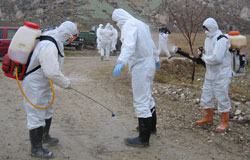Behavior Change Communications
| |
 |
|
|
|
 |
| |
A team of U.S. government and local health experts dressed in personal protective equipment (PPE) use decontamination spray after investigating an outbreak of highly pathogenic avian influenza H5N1 in wild birds and domestic poultry in Turkey, January 2006. Source: Dr. Gavin Macgregor-Skinner/USAID |
|
|
|
|
|
|
Highly pathogenic avian influenza (HPAI) due to H5N1 remains primarily an animal disease, and eradication of the virus needs to happen at the farm level or where humans interact with birds. Containing and stopping the spread of this virus is the only means of decreasing the opportunity for its possible evolution into the next human pandemic influenza virus. Early detection must be harmonized with rapid and intensive outbreak communications to prevent further spread, bring outbreaks under control, derail harmful rumors and misinformation, and reduce public anxiety.
To facilitate public communications as an outbreak intervention, USAID has compiled a matrix of key emergency outbreak and prevention messages that can be quickly adapted and diffused through existing USAID or country communications networks and organizations.
USAID is also employing integrated avian influenza behavior change communications approaches to inform target audiences about the disease and introduce best practices for its prevention and containment. Such approaches include:
- Interpersonal communications that employ agriculture and veterinary extension agents, patient counseling by clinic health staff, and peer educators (farmer-to-farmer, vendor-to-vendor, and vendor-to-consumer)
- Organizational and community outlets, such as workplace, schools, community- and village-level meetings, affinity groups (community groups, farmer organizations, health associations, etc.)
- Mass media, including television, radio, and print
- Public relations/advocacy, such as leader conferences, press briefings to increase the media’s understanding and access to correct and appropriate information, and training of public spokespersons
- Private sector partnerships
In addition, USAID is funding the Communications Initiative to maintain an up-to-date web page on avian influenza. More in-depth information, articles, links to other key web sites, as well as examples of current communications materials, products, and key messages used in avian influenza campaigns, can be found at: www.comminit.com/avianinfluenza.html.
USAID is currently implementing behavior change communications activities for avian influenza through the Academy for Educational Development (AED). Information on this campaign, as well as avian influenza materials and messages, can be found at: www.aed.org/avianflu/.
Latest News and Resources on the USAID Response
- U.S. International Avian and Pandemic Influenza Assistance Approaches $950 Million - 10/25/08
- USAID Continues to Bolster Sri Lanka’s Defense Against Avian Influenza - 10/09/08
- USAID, Agriculture and Health Professionals of the Central Asian Countries Discuss Potential Highly Pathogenic Avian Influenza (HPAI) Pandemic Preparedness - 09/30/08 [PDF, 34KB]
- USAID Has Launched Its Stamp Out Pandemic and Avian Influenza (STOP AI) Project in Central Asia - 09/17/08 [PDF, 31KB]
- Campaign Keeps Avian Flu at Bay - 07/03/08
- U.S. Enhances Azerbaijan’s Preparedness and Capacity to Face Outbreaks of Avian Influenza - 07/01/08
- USAID Supports Sri Lanka’s Efforts Against AI - 06/25/08
- Regional Experts and Governments Cooperating to Battle Avian Influenza Outbreaks - 06/09/08 [PDF, 36KB]
- USAID Launches Region's First Avian Influenza Regional Distribution Center in Thailand - 03/18/08
- USAID Mourns the Loss of Steve Wilbur, Director of USAID | DELIVER Project's Avian Influenza Task Order - 02/25/08
- U.S. Provides Additional Funding for Avian Flu Fight in India - 02/21/08
- USAID Donates More Equipment to Help Fight Spread of Avian Influenza in Pakistan - 01/23/08
- "Substantial Progress" in Global Avian Flu Response, Report Says - 12/04/07
- Nations Examine Pandemic Flu Preparedness at India Conference - 12/03/07
- U.S. Government Provides an Additional $10.5 million to Vietnam for Avian and Pandemic Influenza Prevention and Control - 11/07/07
- USAID Continues to Strengthen Avian Influenza Surveillance and Response in Turkmenistan - 09/18/07 [PDF, 48KB]
- Food and Agriculture Organization (FAO) Develops Community-Level Avian Influenza Surveillance in Indonesia with USAID Support - 07/26/07
- The U.S. Government, through USAID, to Provide up to $24 Million in AI Support to Egypt Over the Next Three Years - 07/01/07
- Report: U.S. Leads Avian Influenza Efforts - 06/21/07
- Fact Sheet: USAID: Investing in People - 05/31/07
- USAID Donates Avian Influenza Protective Gear To Pakistan - 05/01/07
- USAID Bolsters International Avian Influenza Response - 03/30/07
- USAID to Strengthen Delivery of Avian Influenza Commodities Globally - 03/30/07
- U.S. Officials Offer Pandemic Flu Aid in Egypt, Switzerland - 02/23/07
- U.S. Ambassador to Indonesia Presents Protective Gear to Aid in the Battle against Avian Influenza - 01/26/07
- United States Announces Additional Donation to Food and Agriculture Organization (FAO) Emergency Programs - 10/11/06
- Statement on Avian Influenza from Randall L. Tobias, Director of U.S. Foreign Assistance and USAID Administrator - 09/21/06
- The U.S. Provides an Additional $3.2 million to Indonesia for Avian Influenza Prevention - 09/15/06
- Fact Sheet: USAID Advances U.S. International Engagement on Avian Flu - 06/16/06
- USAID Announces $5 Million Award to Enhance International Efforts to Track Avian Influenza - 06/09/06
The Global Avian Influenza Network for Surveillance (GAINS) will enhance international efforts to collect and analyze laboratory samples from wild birds and identify genetic changes in the virus.
Related USAID Programs
Additional Information on Avian Influenza (Bird Flu)
|